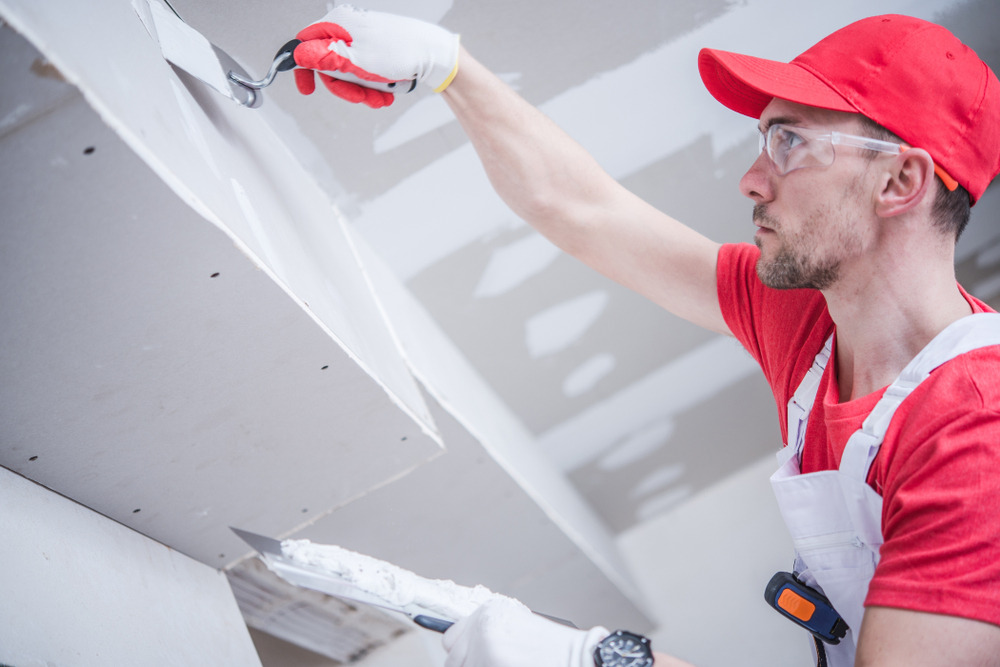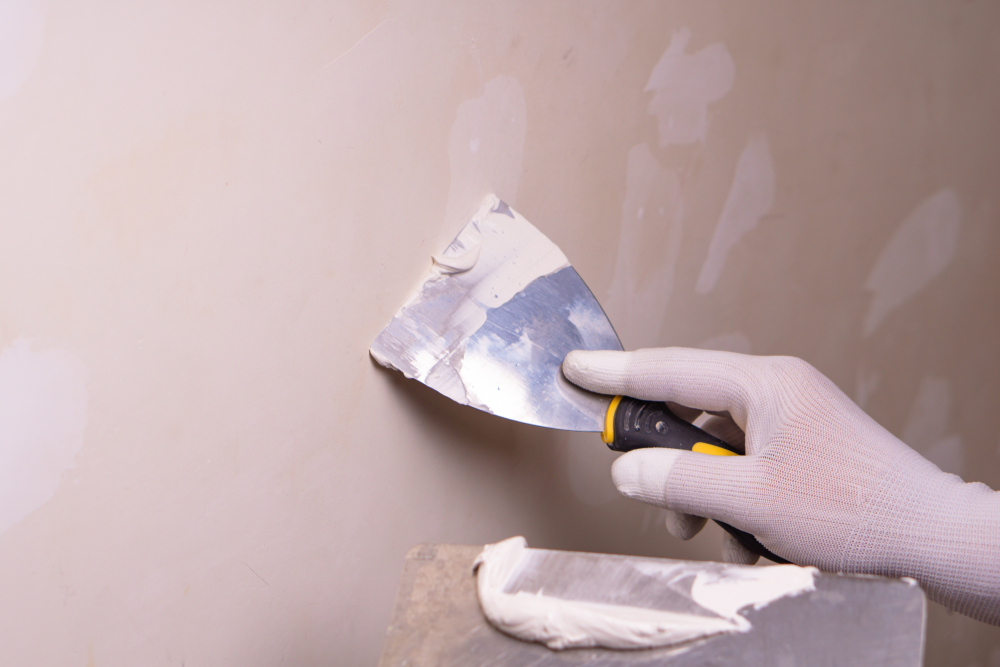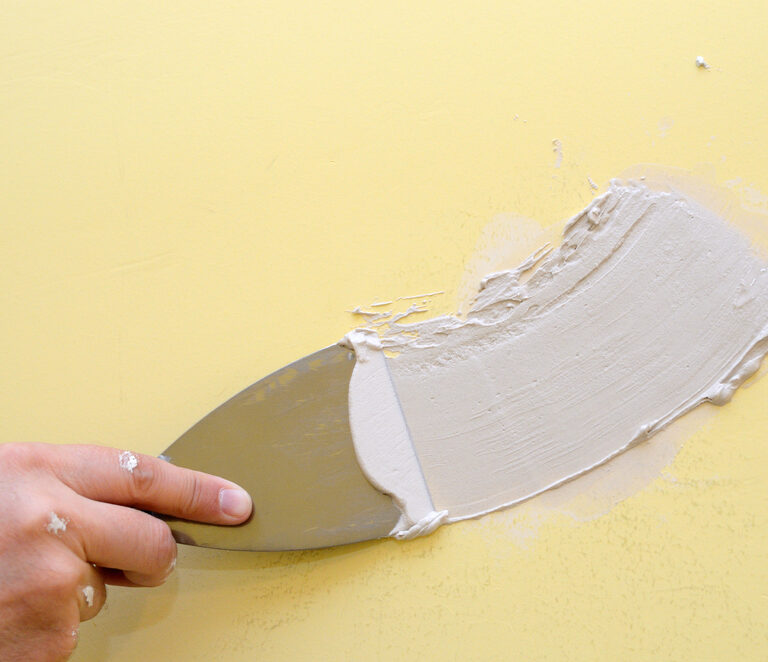Joint compound and spackle have similar uses and tend to pop up at about the same stage of your home renovation.
They even have the same basic ingredient. Given that they seem almost identical, how does the DIY renovator decide between joint compound vs spackle? We’ll answer that question in this guide as we discuss what joint compound and spackle are each meant to do, and how to tell which bucket of goop to grab for which job.
What Is Joint Compound?

Sometimes known as drywall mud, joint compound is a powder that you mix with water to get to a putty consistency (or cake frosting consistency). It’s typically made of gypsum but might be a blend of different minerals.
Its main job comes in right after you’ve put up new drywall. Hence, the name drywall mud. You’ll use it to finish corners, edges, and seal the joints between boards. Hence, the name joint compound.
The mud comes in four varieties:
- Taping compound. This is used as the first (and sometimes second) layer on fresh drywall. It dries to a harder finish than other compounds to create a strong seal. You apply it directly over the drywall tape. Hence, the name (this stuff has a habit of sticking to very literal names).
- Topping compound. You guessed it: topping compound goes on top of the taping compound. It’s the final layer that dries a little softer than the bottom layer so you can easily sand all the patches and seams smooth. Without this top layer, sanding down the taping compound is a chore and the risk of finding noticeable seams in your walls after painting is high.
- All-purpose compound. This stuff is pre-mixed with water and ready to use out of the bucket. It can be used as both taping and topping compound. However, to get this versatility, it loses some of the durability of the previous two. It’ll cut work time down for corners and edges, but you’ll probably want to stick to the taping/topping combo for the larger joints in your drywall.
- Quick-setting compound. This stuff dries faster by using a special formula that creates a chemical reaction that creates a little heat so the compound dries faster. This is why it’s also sometimes called “hot mud.” It’s best used as a first layer to fill in deep cracks, joints, or holes. Once mixed with water, that chemical reaction starts so make small batches at a time and apply it quickly.
When to Use Joint Compound
Joint compound isn’t quite as versatile as spackle but keeping a bag of powder in your tool shed will come in handy. Here are the main situations when you’ll need to mix up a batch of joint compound:
You Just Hung New Drywall
Joint compound is almost exclusively used at the drywall installation stage of a home renovation project. That’s what it was made for and that’s where its unique muddy properties shine brightest. It fills in joints, holds drywall in place, seals the seams along edges and corners, and ultimately transforms your drywall into a solid, smooth wall that’s ready to paint.
Skim Coating
Skim coating is a process which uses diluted joint compound to create a thin coat of joint compound on a wall or ceiling. You can either use it to add texture to walls or to smooth over texture that was added before you moved in (to avoid having to sand down all those textured walls).
Skim coating is also useful after removing wallpaper or while prepping walls that are full of minor cracks and damage. If patching over each individual damage site would leave you with more patches than wall, it might make sense to just skim coat the entire wall.
To do this, you just add more water than usual to your mix so that you have a runnier consistency. It should be closer to paint in consistency. Then, apply it like you would paint, but use separate rollers and brushes so it doesn’t harden on your painting tools. You typically want to apply two coats if you’re smoothing out a surface.
For adding texture, add a little less extra water. It should still be runnier than it is when you’re using it as actual drywall mud, though. Aim for a thick pancake batter. Use a trowel apply it to the walls and then dab at freshly applied compound with a sponge to create the final texture you want.
You Don’t Have Spackle
One advantage joint compound has over spackle is that it can do both jobs. Spackle couldn’t seal a joint or larger hole to save its life. However, in a pinch, you could patch knicks and scratches with joint compound if you don’t have any spackle on hand.
Sure, it’s a little more annoying to use than spackle since you’ll have to mix up a batch just to touch up a couple minor injuries. It’s also harder to sand down than spackle and doesn’t bond as well to surfaces that aren’t drywall.
So, in an ideal world, you come to the job armed with both—but if you were only going to show up with one, make it joint compound.
What Is Spackle?

Spackle doesn’t have nearly as many names as joint compound, but we don’t love it any less for that. Like the many-named mud, spackle is made of gypsum powder, but that powder is mixed with glue and hydrated calcium sulfate.
This creates a stickier, more flexible putty that’s better for small nicks and cuts in your walls like nail holes and furniture nicks. The gooey binders in the formula are not only to help it bond to the surface but also to minimize shrinkage.
When joint compound dries, the water loss causes it to shrink as it hardens. Spackle won’t do this. So, you can patch holes with a single layer and spend less time waiting for the putty to dry. The consistency also makes it easier to scrape it to a smooth, level layer before it dries without just removing clumps of mud, so you won’t spend as much time sanding it down after it dries.
Spackle comes in three varieties:
- Vinyl. Vinyl spackle dries quickly and is good at bonding to any surface whether it’s drywall, plaster, wood, brick, or even stone. It doesn’t crumble or crack and it’s easy to sand.
- Acrylic. Acrylic spackle is a bit heavier than vinyl and equally versatile in terms of which surfaces it can bond to. The thicker consistency makes it better for bigger holes since it can fill in the area instead of just creating a seal on top of it.
- Epoxy. This spackle is just for wood. It’s waterproof and works as an adhesive and filler at the same time so that cracks in wood are closed off and held together to prevent further cracking.
Each option can be either lightweight or heavy duty (the label will tell you which). Lightweight spackle is for tiny dings and cracks, less than a ¼-inch. Heavy-duty spackle is for slightly bigger holes and cracks or for areas where damage could happen again (like that one spot on the wall that your doorknob seems to hold a grudge against).
When to Use Spackle
Here are the main situations where a tub of spackle is called for. As mentioned earlier, if you don’t happen to have spackle on hand and you’re not up to taking a trip to the store, you can usually sub joint compound for most of these situations (except where we noted otherwise). Even so, using spackle in these situations will make the job a lot easier and a lot faster:
You’re Repairing Minor Damage to Drywall or Plaster
The reason spackle is preferable to joint compound for minor repairs is because it’s less work. To patch a nail hole or small crack, you just apply it, scrape off the excess with the same putty knife, and then let it dry. At most, it might require a little buffing with extra fine sandpaper, but you won’t need to sand it down nearly as much as you would joint compound.
It also doesn’t shrink as much so you don’t have to worry about the crack or hole reappearing after it dries. It might recess slightly into larger cracks or holes but, usually, you’ll notice this as you’re applying it so you can add additional layers right away instead of coming back after drying.
You’re Repairing Something Besides Drywall or Plaster
Joint compound doesn’t bond as well to things that aren’t drywall. You can get it to patch wood if you’re patient, but only if you plan to paint that wood right after (because joint compound dries white).
Spackle, on the other hand, has binders added to the mix that make it a little more versatile. It bonds readily to wood, brick, stone, and even metal. Different formulas work better for different surfaces—epoxy spackle works best for wood, for example—but all of them will work better than joint compound.
So, if the damage is on something other than drywall or plaster, spackle is probably a better choice. Also, if you’re binding two materials together—like sticking metal siding onto a wood house—spackle would adhere to both materials better than joint compound, giving you a more secure bond.
You Need a Quick Fix for Larger Holes
If all you have is a tub of spackle and a lamp-sized hole in your wall that you need to seal off the wall right away until you have time to do a proper drywall repair, it is possible. For larger holes or cracks, a good temporary fix is to place a bridge material—plywood, sheet metal, or anything similar you have around the house—and fix it to the wall by spackling the edges.
It’s not pretty but it will keep pests and other problems out of your house until you can do a more permanent repair. This is an especially helpful quick fix to know when damage has been done to the exterior or to your roof.
Final Thoughts
Regardless of which material you choose, it’s important to make the right decision. Before you start any project, take some time to carefully consider which option is right for you. This way, you don’t make a mistake that will cost you time and money in the future.
